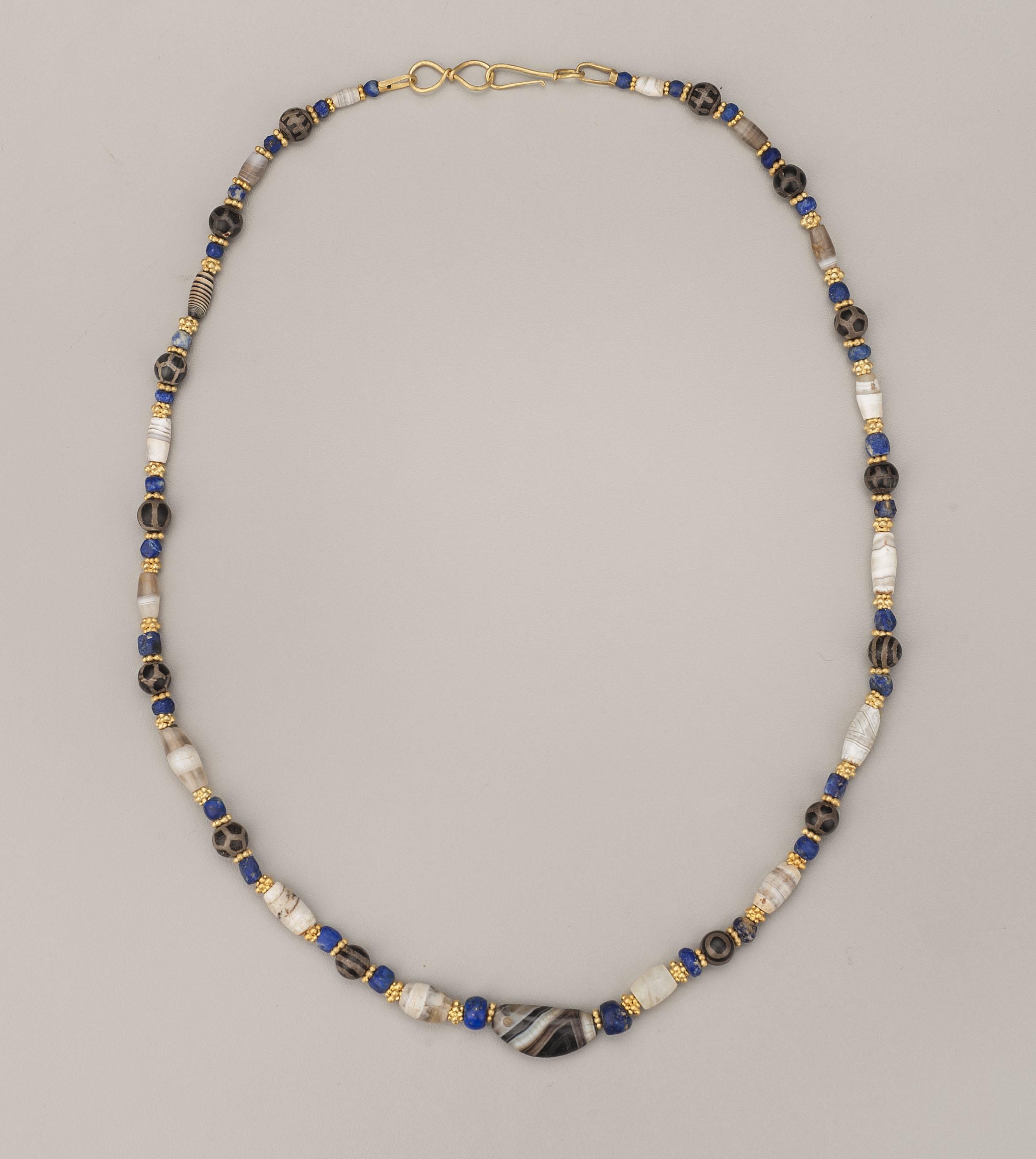Ancient Agate, Chalcedony, and Gold Necklace with Agate Bow Bead Center
Collection:
Agate
Material:
Agate, Chalcedony, Lapis Lazuli, 20k gold
Size:
The necklace is 25 ¼ inches (64 cm) in length. The necklace weighs 50.2 gm.
Price:
$7,500.00
A necklace of sixteen agate barrel beads each faced with a three layer gold granulated bead alternating with fourteen spherical etched agate beads each faced with a pair gold granulated ring beads and a pair of small lapis lazuli beads. The center agate bead in the necklace is a “bow” bead with banding of black, brown, opaque white quartz and transparent quartz. It is 2.9 cm in length, 1.18 cm in width and 7 mm in thickness. The end width is 5 mm. The hole diameter is 1.5 mm. The lapis lazuli beads range in size from 6 mm in length at the center to 3 mm at the back. They range in diameter from 7,.5 mm to 4 mm. They are mostly flattened spheres and barrel shapes but there are also some roughly cuboid shapes as well as a cornerless cube bead. The agate barrels also graduate in size from the center of the necklace. The black spherical agate beads are 7.9 mm in diameter and decorated with four different patterns: Seven have a pentagonal cell in two registers that is based on a dodecahedron. Three have four concentric circles, two on opposite sides resulting in two “eyes” on opposite faces. Two have a circle at the equator with marks at right angles to it alternating above and below the line making a kind of saw tooth. The ends also have an encircling border line parallel to the center line. One bead has the two circles on either end connected with six lines. The etching of agate and carnelian beads is accomplished by painting onto the surface of the bead as alkali (potash, white lead, and washing soda have all been reportedly used), and then subsequently firing the bead. This permanently whitens the area of the bead covered with the alkali. The whitening is not merely a glazing of the surface. The surface is often unaffected by this process; the whitening actually occurs beneath the surface and extends downward into the stone. The whitened areas may be raised on some specimen; in a few cases, the designs are sunken into the stone, the solution having acted like a flux as it was absorbed into the surface and melted the structure of the agate or carnelian. Etched beads have been manufactured since very early times. Beck attributed the specimens known to him to three main periods: Early (before 2000 BC), Middle (300 BC to 200 AD), and Late (600 to 1000 AD). Francis has expanded and revised this dating as follows: Early (2700 BC to 1800 BC), Middle (550 BC to 200 AD), and Late (224 to 642 AD). Etched beads from the earliest period have been found mainly at Mesopotamian and Indus civilization sites. The centers of their manufacture discovered so far are the Indus civilization sites of Lothal and Chanhu Daro. Middle period etched beads were found mainly at Indian subcontinent sites. Francis makes a strong case that the centers of manufacture of Late period etched beads was Iran and dates them to Sassanian times (224 to 642 AD). The round etched beads in this necklace have very similar patterns to those etched agate beads from the Kushan empire of what is now north India and Pakistan. They are most similar to etched agate beads from from the Middle Period. The sixteen gold granulated beads, four of each in four different sizes and the beading tips and hook and eye clasp are all 20k.
